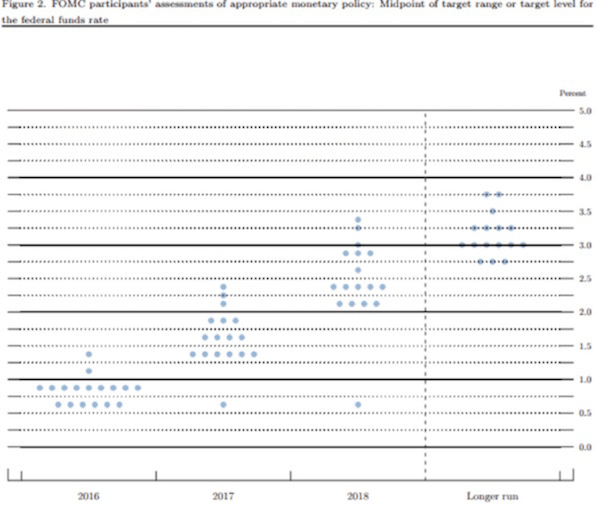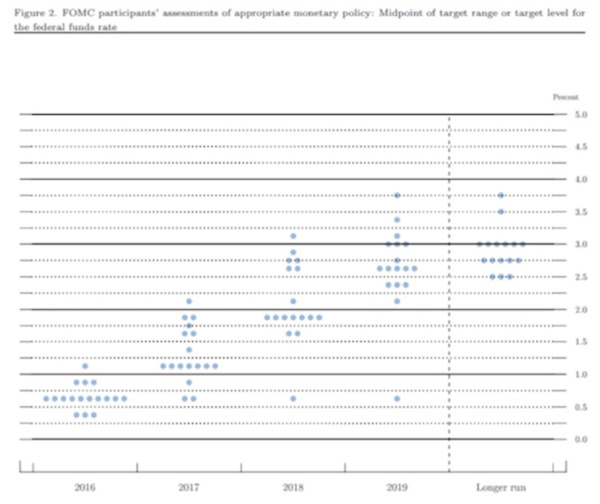The new dot plots, showing where FOMC members expect interest rates to be in the future, recently came out. If you were to look at this predictive path in isolation, you would make the rational assumption that interest rates are going to rise by 2% or more in the next two years.
The chart below shows the FOMC’s expected rate should have increased four months ago. In June, by a margin of two to one, they expected at least two rate increases (if not more)this year.

Has the economy changed much since then? Not really, but somehow—afraid of their own shadow—FOMC members are now projecting (by a three-to-one margin) that there will be only one rate increase this year… of 25 basis points or less.
Here’s the plot from the September meeting:

The Schizophrenic Fed
This constant rethink is not just a recent phenomenon. We’ve seen it ever since the FOMC began to give us their forecasts for interest rate hikes.
Less than two years ago, they were expecting today’s rates to be around 3%… and to reach 4% by the end of 2018! Each subsequent quarterly plot is revised downward, but the pattern remains the same.
Rates are going to “normalize” in a time frame that is always just around the corner but never seems to arrive. The chart below, from Business Insider, shows the paths of their rate predictions. The dotted line down at the bottom shows what has actually happened.

This reveals an interesting dichotomy. The Fed determines what interest rates will be. So what they’re doing is predicting what their own decisions will be.
Federal Reserve economists have basically gone “0-fer” with all their predictions for the growth of the economy. This is a predictive task that is orders of magnitude more difficult than predicting what they will decide on interest rates. But, they have also gone 0 for 11 quarters with their predictions for their own monetary policy!
Between the time they make their forecasts and the time they actually have to make a decision, something always happens to keep them from pulling the trigger. I think that something is Yellen and her inside crowd of ultra-doves in the leadership of the Fed.
The biggest danger of all
This brings us to my main point: People are losing faith in the Federal Reserve. And not without reason. Ben Hunt says the Fed is “losing the narrative.” By that, he means that most Americans are skeptical of the Fed’s happy talk and no longer think that Fed policies will result in the economic growth projected.
We will have another financial crisis and/or recession, probably soon, and we can’t trust the Fed to respond correctly.
We’ll be lucky if whatever comes out of their Frankenstein lab is only ineffective. There’s a very real risk they will make the situation far worse. The masses of unprotected people are in no mood to swallow more monetary policy medicine.
In an ideal world, we might be glad to see the Fed stand aside and let markets adjust themselves. The problem is that any adjustment will now be extremely painful for a large part of the population.
So the Fed may be damned if it does and damned if it doesn’t.
Past results are not indicative of future results. There is risk of loss as well as the opportunity for gain when investing in managed funds. when considering alternative investments, including hedge funds, you should consider various risks including the fact that some products: often engage in leveraging and other speculative investment practices that may increase the risk of investment loss, can be illiquid, are not required to provide periodic pricing or valuation information to investors, may involve complex tax structures and delays in distributing important tax information, are not subject to the same regulatory requirements as mutual funds, often charge high fees, and in many cases the underlying investments are not transparent and are known only to the investment manager. All material presented herein is believed to be reliable but we cannot attest to its accuracy. All material represents the opinions of John Mauldin. Investment recommendations may change and readers are urged to check with their investment counselors before making any investment decisions. Opinions expressed in these reports may change without prior notice.
Recommended Content
Editors’ Picks
EUR/USD extends gains above 1.0700, focus on key US data

EUR/USD meets fresh demand and rises toward 1.0750 in the European session on Thursday. Renewed US Dollar weakness offsets the risk-off market environment, supporting the pair ahead of the key US GDP and PCE inflation data.
USD/JPY keeps pushing higher, eyes 156.00 ahead of US GDP data

USD/JPY keeps breaking into its highest chart territory since June of 1990 early Thursday, recapturing 155.50 for the first time in 34 years as the Japanese Yen remains vulnerable, despite looming intervention risks. The focus shifts to Thursday's US GDP report and the BoJ decision on Friday.
Gold closes below key $2,318 support, US GDP holds the key

Gold price is breathing a sigh of relief early Thursday after testing offers near $2,315 once again. Broad risk-aversion seems to be helping Gold find a floor, as traders refrain from placing any fresh directional bets on the bright metal ahead of the preliminary reading of the US first-quarter GDP due later on Thursday.
Injective price weakness persists despite over 5.9 million INJ tokens burned

Injective price is trading with a bearish bias, stuck in the lower section of the market range. The bearish outlook abounds despite the network's deflationary efforts to pump the price.
US Q1 GDP Preview: Economic growth set to remain firm in, albeit easing from Q4

The United States Gross Domestic Product (GDP) is seen expanding at an annualized rate of 2.5% in Q1. The current resilience of the US economy bolsters the case for a soft landing.